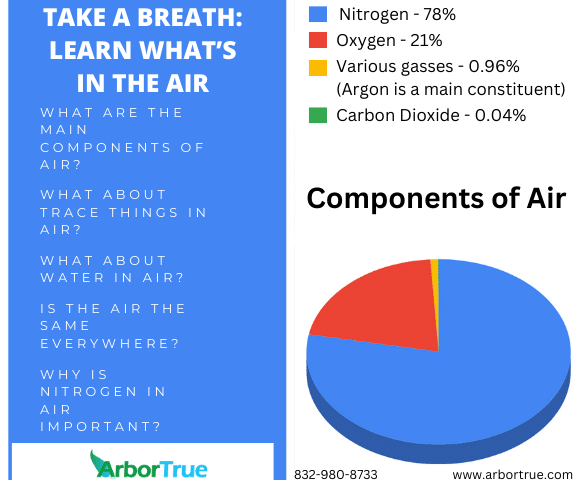
Mushroom Monday: Webcap Mushrooms (Cortinarius multiformis)
September 2, 2024
Long-term Effects of Drought: A Guest Blog Post By Arborist Brittany Bates
September 6, 2024
Take a Breath: Learn What’s in The Air
Have you ever thought about what’s in the air we breathe? Air is vital for life, but it can seem a bit of a mystery. In today’s TrueTreeTalk blog post, learn what’s in the air around us.
What are the Main Components of Air?
If you were to measure air without any water vapor, you would find that it contains approximately:
Nitrogen – 78%
Oxygen – 21%
Various gasses – 0.96% (Argon is a main constituent)
Carbon Dioxide – 0.04%
Water vapor in air generally ranges from between 0% and 4% of the volume of the air. As the percentage of water vapor increases, the relative percentage of the other gasses is reduced. The amount of water vapor in the air changes with conditions and it varies from place to place.
What About Trace Things in Air?
A very small percentage of air is made of a variety of different things. It amounts to around 0.07% of dry air, and includes things like pollen, spores, particles (known as aerosols), bioaerosols (organisms in the air) and trace amounts of various gasses. Although these things make up a small percentage of air, they can have a big impact on the quality of air. The components of this small percentage, make up the things in air we think of as pollution.
Various gasses in air that occur in trace amounts include things like helium, hydrogen, methane, ozone, and carbon monoxide.
What About Water in Air?
As we mentioned above, water makes up between 0% and 4% of air. Water can exist in the atmosphere as a liquid, a solid, and a gas.
The amount of water in air is measured as relative humidity. This number is relative to how much water could be held by an amount of air before the water would fall as rain. This amount is 100% and the humidity is measured relative to it.
Is the Air the Same Everywhere?
The composition of air can vary depending on altitude, latitude, and local conditions. This variability can be in the amount of water and in the amounts of trace materials in air. The major components of air (nitrogen, oxygen, carbon dioxide, and argon) are relatively uniform though because of mixing in air because of wind. This is generally the case closer to the earth, but as you increase in altitude, gasses that are lighter increase in relative proportions.
Why is Nitrogen in Air Important?
Although we breathe oxygen, nitrogen in air is important for a number of reasons. For example, nitrogen is important for plants and animals (it is used among other things to build proteins) and it dilutes the oxygen that’s in the air, reducing burning that could happen.
If you liked learning about what’s in air, check out the other posts on our TrueTreeTalk blog. Follow us on Facebook to keep up with these and other posts. Check back for later posts where we may take a deeper look into the different components of air.
* * *
ArborTrue is a science-based tree-service company in the greater Houston area. We also serve Austin and other parts of Central Texas. We provide a range of services including tree trimming, tree pruning, tree removal, tree planting, arborist consultations, and more. Call us today at 832-980-8733 (Houston) or at 512-546-3833 (Austin) or reach out to us online to schedule an appointment.




